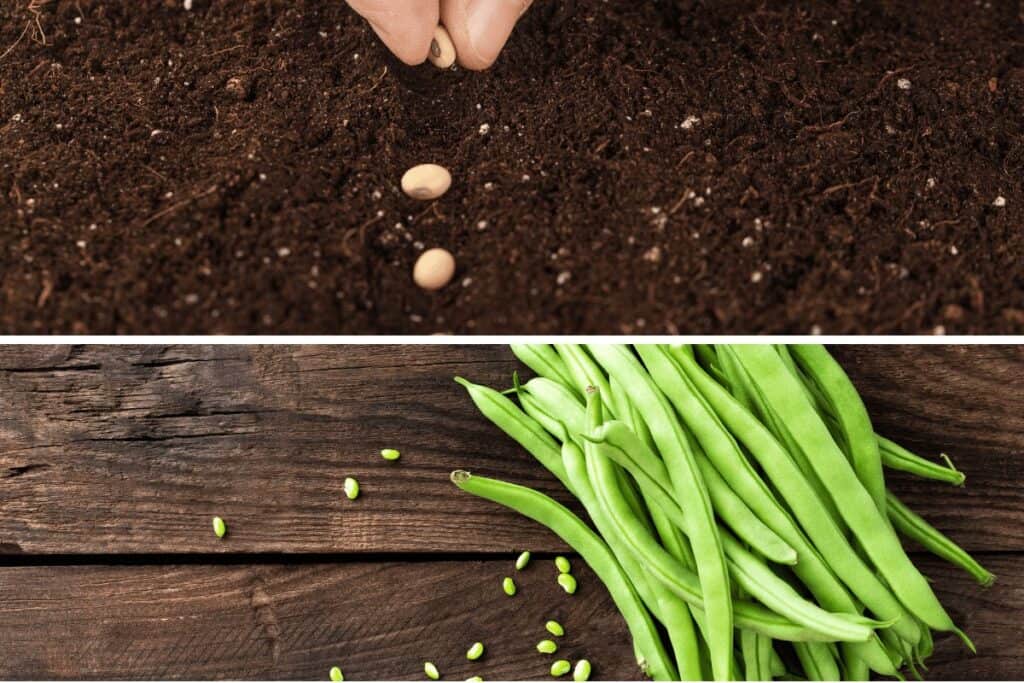Green beans are a delicious and nutritious addition to any garden. Whether you’re a seasoned gardener or a beginner, planting green beans is easy and rewarding.
In this guide, we’ll take you through How to Plant Green Beans: A Comprehensive Step-by-Step Guide, so you can enjoy a bountiful harvest in no time.
Choosing the Right Spot
When it comes to planting green beans, choosing the right spot is crucial for their successful growth. This not only involves finding a location that has the appropriate amount of sunlight but also taking into account other factors such as soil quality and water availability.
Here are some additional details on how to choose the right spot for planting green beans.
- Sunlight: Green beans require at least 6 hours of direct sunlight a day, so it is important to choose a spot that gets enough sun exposure. Planting them in a location that is shaded for most of the day will result in stunted growth and lower yields. [3]
- Soil Quality: Green beans prefer well-drained soil that is rich in organic matter. The soil should be loose and crumbly, allowing for easy root growth and water absorption. Avoid planting in areas with heavy clay soil, as it can retain too much water and suffocate the roots. Adding compost or other organic matter to the soil can improve its quality and provide the necessary nutrients for healthy growth. [1]
- Water Availability: Green beans need consistent moisture to thrive, so it is important to choose a location that is easily accessible for watering. Avoid planting in areas that are prone to flooding or standing water, as this can lead to root rot and other issues. If planting in a raised bed or container, make sure there is adequate drainage to prevent water from pooling. [3]
- Spacing: When selecting the spot for planting green beans, consider the space required for the plants to grow. Depending on the variety, green beans can grow up to 8 feet tall and 2 feet wide. Make sure to provide enough space between each plant to allow for proper air circulation and prevent overcrowding. [2]
By taking these factors into consideration, you can choose the ideal location for planting green beans and help ensure a bountiful harvest.
Planting Green Beans

Now that you’ve found the perfect spot for your green beans, it’s time to start planting. Follow these steps:
- Prepare the soil: Before planting, you should prepare the soil to create a suitable growing environment for your green beans. Loosen the soil to a depth of 6 to 8 inches and mix in some organic matter, such as compost or well-rotted manure. This will help to improve soil drainage and provide essential nutrients for your plants.
- Choose the right seeds: Green beans come in many different varieties, so choose a variety that is suitable for your growing conditions. Some popular green bean varieties include bush beans, pole beans, and snap beans. Read the seed packet to learn about the ideal planting time and spacing for your chosen variety.
- Plant the seeds: Green beans can be planted directly in the ground once the soil has warmed up and all danger of frost has passed. Plant the seeds about 1 inch deep and 2 to 4 inches apart in rows, with rows spaced about 18-24 inches apart. If you’re planting pole beans, be sure to provide a trellis or support structure for them to climb.
- Water the seeds: Green beans need consistent moisture to germinate and grow properly. Water the seeds immediately after planting, and then water them regularly, keeping the soil evenly moist but not waterlogged. Avoid watering the plants from overhead, which can increase the risk of disease.
- Fertilize the plants: Green beans are heavy feeders, so they benefit from regular fertilization. Apply a balanced fertilizer, such as a 10-10-10 formula, at the time of planting and then every 3-4 weeks throughout the growing season.
- Control pests and diseases: Green beans are susceptible to various pests and diseases, such as aphids, spider mites, and powdery mildew. Monitor your plants regularly and take action at the first sign of a problem. You can use organic pest control methods, such as insecticidal soap or neem oil, or seek advice from a gardening expert.
By following these steps, you can successfully plant green beans and enjoy a bountiful harvest. Remember to harvest the beans regularly, as this will encourage the plants to produce more beans and prolong the growing season.
Caring for Your Green Beans

Once your green beans have sprouted, it’s important to care for them properly. Here’s what you need to do:
- Watering: Green beans need consistent moisture to thrive, especially during the flowering and pod formation stages. Water them deeply once or twice a week, depending on the weather conditions and soil moisture level. Avoid overhead watering, which can promote disease and damage the plants. Instead, use a drip irrigation system or water the plants at the base.
- Mulching: Mulching is a great way to conserve soil moisture, suppress weeds, and regulate soil temperature. Apply a 2-3 inch layer of organic mulch, such as straw or chopped leaves, around the base of your green bean plants. This will help to keep the soil cool and moist and reduce the need for watering.
- Fertilizing: Green beans are heavy feeders and require regular fertilization to grow and produce a good harvest. Apply a balanced fertilizer, such as a 10-10-10 formula, every 3-4 weeks throughout the growing season. Alternatively, you can use organic fertilizers, such as compost or fish emulsion, to nourish your plants.
- Controlling pests and diseases: Green beans are susceptible to various pests and diseases, such as aphids, spider mites, and powdery mildew. Monitor your plants regularly and take action at the first sign of a problem. You can use organic pest control methods, such as insecticidal soap or neem oil, or seek advice from a gardening expert.
- Harvesting: Green beans are ready to harvest when the pods are firm, crisp, and plump, but still tender. Pick the beans regularly to encourage more production and prevent the pods from becoming tough and stringy. Use sharp scissors or pruning shears to cut the pods from the plant, taking care not to damage the stems or leaves.
By following these tips, you can care for your green bean plants and ensure a successful harvest. Remember to be patient and consistent in your care, and don’t hesitate to seek advice from a gardening expert if you encounter any problems or challenges.
Harvesting Your Green Beans
100 pcs String Beans Seeds

Green Beans Seeds Vegetables Green Non-GMO Plants That Do Not Require Much Care
About this item
- String bean seeds are one of the common vegetables on the table.
- String beans seeds sowing points: can be sown or transplanted in the nursery, 3 to 4 seeds per hole, cover about 2 cm, keep it moist if the weather is too dry when the film.
- Indoor or outdoor-carefully selected String beans seeds can be easily grown in the kitchen, inside the entrance, or outside the garden.
- Soil: Green beans are suitable for planting in loose, fertile, and well-drained soil. General sandy soil and slightly sticky soil can also grow normally, but should not grow in low-lying soil that is prone to water accumulation.
When your green beans are ready to be harvested, you’ll know it. Here’s how to do it:
- Timing: Green beans are ready to harvest when the pods are firm, crisp, and plump, but still tender. The ideal harvesting time depends on the variety and growing conditions, so check the seed packet or consult a gardening expert for guidance. Generally, bush beans are ready to harvest 50-60 days after planting, while pole beans may take 60-80 days.
- Frequency: Green beans produce new pods continuously, so it’s important to harvest them regularly to encourage more production and prevent the pods from becoming tough and stringy. Depending on the size of your garden and the number of plants, you may need to harvest every 1-2 days during peak season.
- Method: To harvest your green beans, use sharp scissors or pruning shears to cut the pods from the plant, taking care not to damage the stems or leaves. Hold the stem with one hand and the pod with the other, and snip the pod close to the stem. Alternatively, you can gently pull the pod off the plant by hand, but this may damage the stem and reduce future production.
- Storage: After harvesting, rinse the beans in cold water to remove any dirt or debris. If you’re not using them immediately, store the beans in a plastic bag or container in the refrigerator. They should stay fresh for 4-5 days. Alternatively, you can blanch and freeze the beans for long-term storage.
- Saving seeds: If you’re growing heirloom or open-pollinated green bean varieties, you can save the seeds for future planting. To do so, leave a few pods on the plant until they dry out and turn brown. Remove the seeds from the pods and store them in a cool, dry place in an airtight container.
By following these tips, you can harvest your green beans at the right time and in the right way to maximize their flavor and nutrition. Don’t forget to enjoy the fruits of your labor by cooking and eating your fresh, delicious green beans in your favorite dishes!
FAQ
Q: When should I plant my green beans?
A: Green beans should be planted after the last frost when the soil has warmed up to at least 60°F.
Q: How deep should I plant my green bean seeds?
A: Plant your green bean seeds about 1 inch deep.
Q: How often should I water my green beans?
A: Aim to water your green beans about once a week, providing about an inch of water each time.
Q: How long does it take for green beans to mature?
A: Green beans typically take 50-60 days to mature, but this can vary depending on the variety.
Q: Can I plant green beans in containers?
A: Yes, green beans can be grown in containers as long as the container is at least 8-10 inches deep and has proper drainage.
Conclusion
Planting green beans is an easy and rewarding experience. By following this step-by-step guide, you can ensure a bountiful harvest of delicious and nutritious green beans. Happy planting!
Recent Posts
- What Types of Lettuces Can You Grow?

- How to Plant Onion Seeds for Maximum Germination

- How to Plant Parsnip Seeds for Maximum Germination

- How to Plant Mushroom Seeds for Maximum Germination

- How to Plant Lettuce Seeds for Maximum Germination

- How to Plant Kale Seeds: A Step-by-Step Guide to Maximum Germination Success!





